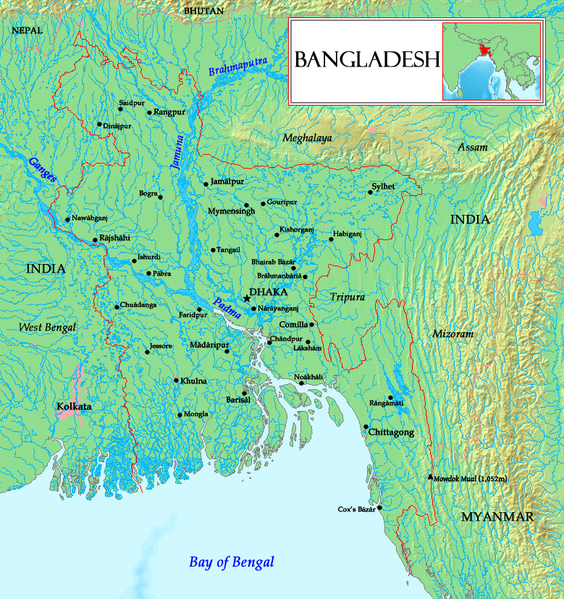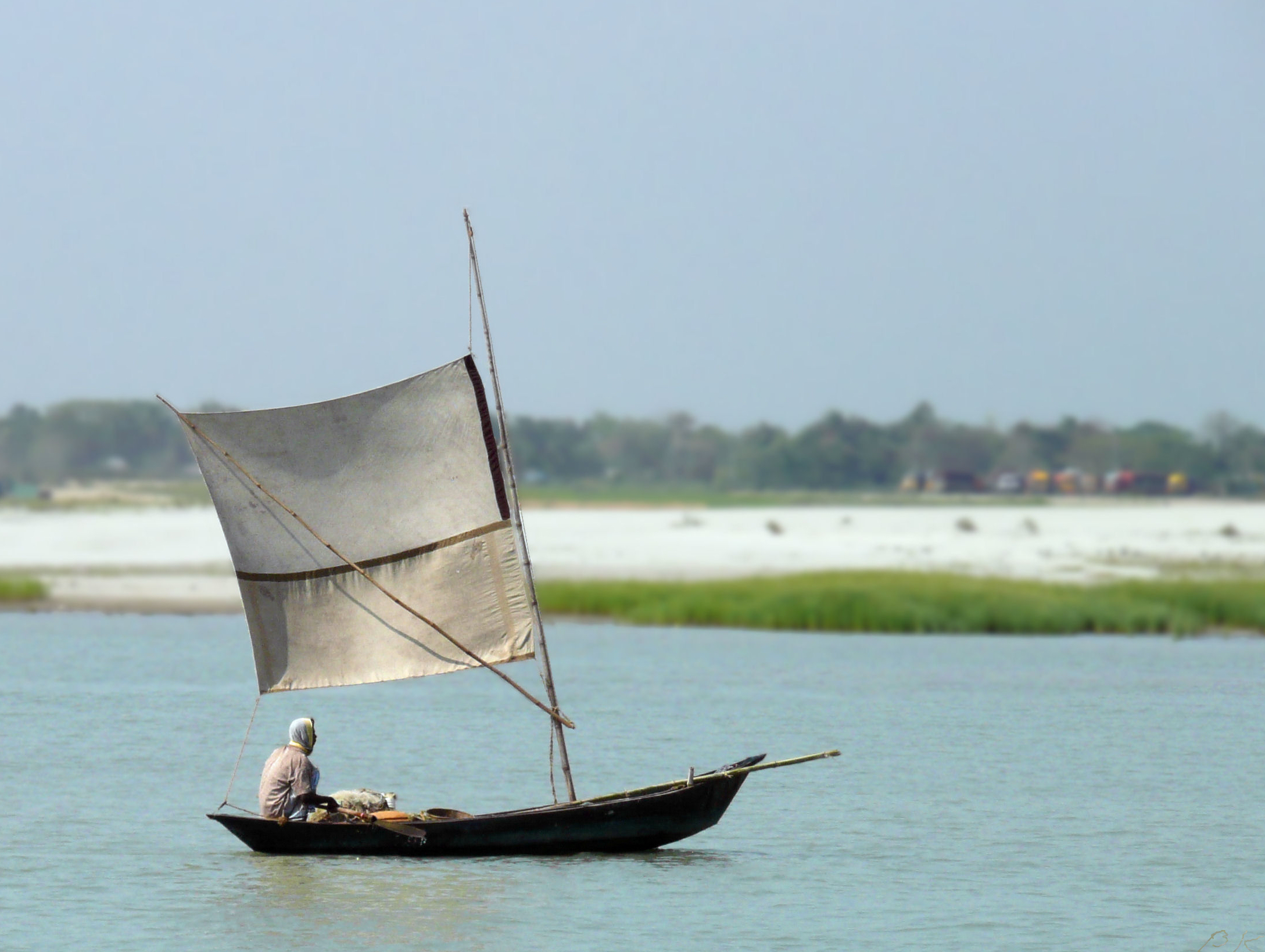| Padma River | |
|---|---|
Padma River in Bangladesh | |
| Origin | Himalayas |
| Mouth | Bay of Bengal |
| Basincountries | India, Bangladesh |
| Location | Nawabganj, Rajshahi, Pabna, Kushtia,Faridpur, Rajbari, and Chandpur District |
| Length | 120 kilometres (75 mi) |
| Avg.discharge | Annual average:
During monsoon season:
During dry season:
|
| River system | Ganges River System |
The Padma (Bengali: পদ্মা Pôdda) is a major trans-boundary river in Bangladesh. It is the main distributary of the Ganges (Bengali:গঙ্গা Gôngga),[dubious ] which originates in the Himalayas. The Padma enters Bangladesh from India near Chapai Nababganj. It meets the Jamuna (Bengali: যমুনা Jomuna) near Aricha and retains its name, but finally meets with the Meghna(Bengali: মেঘনা) near Chandpur and adopts the name 'Meghna' before flowing into the Bay of Bengal.
Rajshahi, a major city in western Bangladesh, is situated on the north bank of the Padma. Its maximum depth is 1,571 feet (479 m) and average depth is 968 feet (295 m).
Course
Originated in the Gangotri Glacier of the Himalaya, the Ganges runs to the Bay of Bengal through India, entering Bangladesh at Shibganj in the district of Chapai Nababganj. Just west of Shibganj, the distributary Bhagirathi emerges and flows southwards as the Hooghly. After the point where the Bhagirathi branches off, the Ganges is officially referred to as the Padma and the river Bhagirathi uses the name of Ganga. Later the British started calling it the Hoogly river.
Further downstream, in Goalando, 2200 km away from the source, the Padma is joined by the mighty Jamuna (LowerBrahmaputra) and the resulting combination flows with the name Padma further east, to Chandpur. Here, the widest river in Bangladesh, the Meghna, joins the Padma, continuing as the Meghna almost in a straight line to the south, ending in the Bay of Bengal.
[edit]Mythology
The Padma (Sanskrit for lotus flower[1]) is numerously mentioned in Hindu Mythologyincluding the Vedas, the Puranas,[2] the Ramayana and the Mahabharata.[citation needed] In all the epic stories, the river is mentioned as byname for the Goddess Lakshmi though the origin differs.
[edit]Damming
After building of Farakka Barrage on the upstream of the river in Indian West Bengal the capacity of the river was reduced significantly.[3]
[edit]Bridge
A road-rail bridge is proposed in 2009.[4]
Padma bridge is the largest bridge of Bangladesh(proposed). It will cost ৳3000 kuti to finish. It will be used in 2013.
Pabna District
The Padma forms the whole of the southern boundary of the district for a distance of about 90 miles. The name Padma is given to the lower part of the course of the Ganges below the point of the off-take of the Bhagirathi (India). Padma had, most probably, flown through a number of channels at different times. Some authors contend that each distributary of the Ganges in its deltaic part is a remnant of an old channel and that starting from the western-most one, the Bhagirathi (in West Bengal, India) each distributary of the east marks a position of a newar channel than the one to the west of it.
It would be worthwhile to mention here the views of Rennell, who referred to a course of the Ganges in the north of its present channel. "Appearances favour very strongly" says Rennell, "that the Ganges had its former bed i,n the tract now Occupied by the lakes and morasses between Natore and Jaffargunge, striking out of the present course by Dhaka to a junction ofBrahmapooter or Meghna near Fringybazar, where accumulation of two such mighty streams probably scooped out the present amazing bed of the Meghna". The places mentioned by Rennell proceeding from west to east are Rampur Boali, the headquarters of Rajshahi district, Puthia and Natore in the same district and Jaffarganj in the district of Dhaka. The place last named were shown in a map of the Mymensingh district dated 1861, as a thana headquarters. about 6 miles south-east of Bera Police Station. It is now known as Payla Jaffarganj and is close to Elachipur opposite Goalunda. According to Rennell's theory, therefore, the probable former course of the Ganges would correspond with that of the present channel of the Baral.
Although conclusive proofs of what has been stated above are lacking, authorities more or less agree that the Ganges has changed its course and that in different times, each Or the distributary might have been the carrier of its main stream.
The bed of the Padma is wide, and the river is split up into several channels flowing between constantly shifting sand banks and islands. During the rains the current is very strong and even steamers may find difficult in making headway against it. It is navigable at all seasons of the year by steamers and country boats of all sizes and until recently ranked as one the most frequented waterways in the world. It is spanned near Paksey by the great Hardinge Bridge over which runs one of the main lines of the Bangladesh Railway.
[edit]Kushtia District
The mighty Padma (the portion of the Ganges between its junctions with Bhagirathi and Brahmaputra also known as the lower Ganges), touches the district at its most northerly corner, at the point where it throws off the Jalangi, and flows along the northern border in a direction slightly south-east, until it leaves the district some miles to the east of Kushtia. It carries immense volumes of water and is very wide at places, constantly shifting its main channel eroding vast areas on one bank throwing chars on the other giving rise to many disputes as to the possession of the chars and islands which are thrown up.
[edit]Photos Gallery
Padma River View



0 comments:
Post a Comment